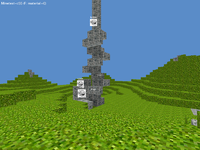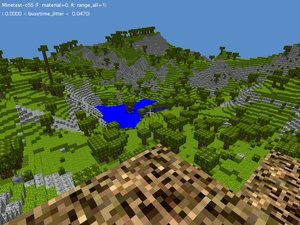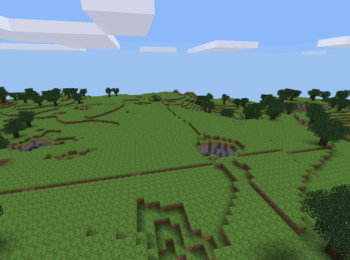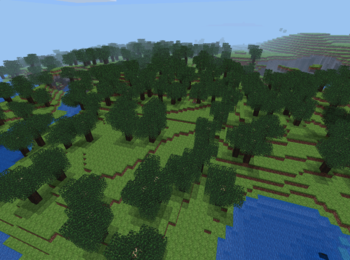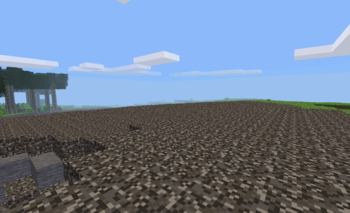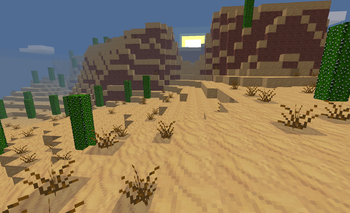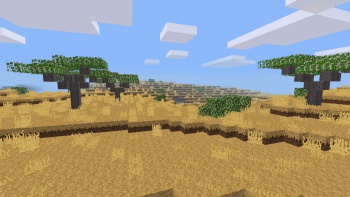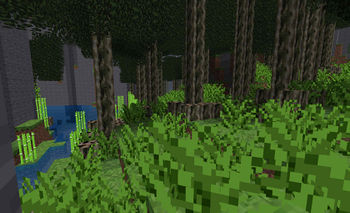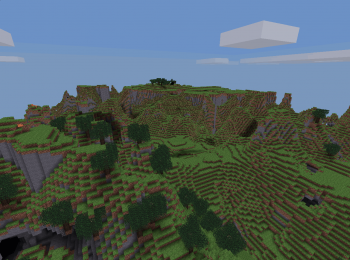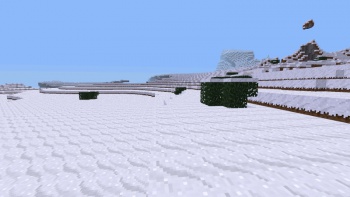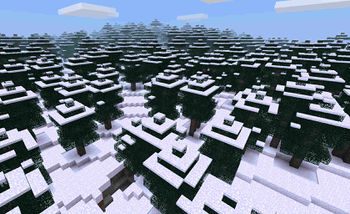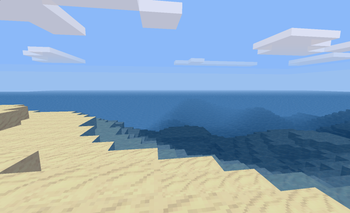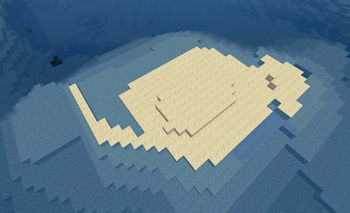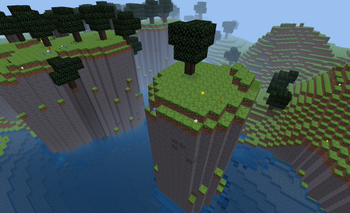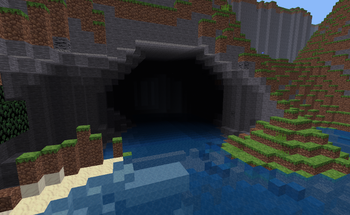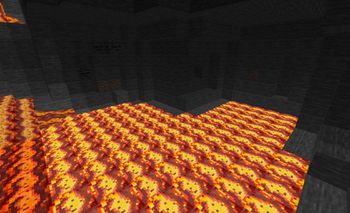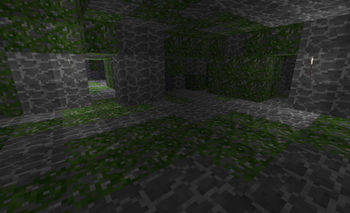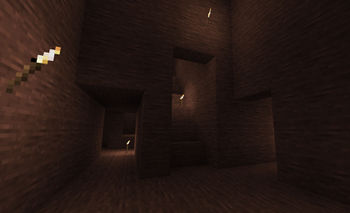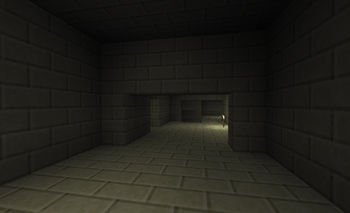Biomes
Jump to navigation
Jump to search
| English • Deutsch • français • Bahasa Indonesia • 日本語 • Bahasa Melayu |
According to Wikipedia, biomes are climatically and geographically defined as similar climatic conditions on the Earth, such as communities of plants, animals, and soil organisms, and are often referred to as ecosystems.
History
Before Minetest had version numbers, biomes were undefinable and only consisted of 4 materials: grass, stone, light and "water" (as seen below.) When 0.0.1 came out it brought actual biomes to the table, but before 0.2.20110529 Pre-Alpha map generation was a bit of a mess. Biomes would cross into each other, and were generally undefinable. So far 0.4 Dev has the most stable biome generation.
For more detail on the evolution of the map generator see the Map Generator Evolution page.
Biome Types
| Name and Features | Description | Images |
|---|---|---|
| Plains Flower, Grass, Dirt with Grass, Dirt |
Plains are a quite flat biome. Large amounts of Dirt nodes and Grass Blocks, on which flowers and Grass may appear naturally in this area (since 0.4.7), are in this biome. Before 0.4.3, long lines used to be carved in plains. | File:Large plains 0.4.7.png Plains biome, as of 0.4.7 |
| Forest Tree and Apple tree, Water |
Forests are the most common biomes in Minetest. Trees and apple trees spawn here naturally. Generally forests can spawn lakes, ponds, and rivers inside of it. Forests usually surround plains. | |
| Pine tree forest Pine Tree, Flower, Grass, Red Mushroom, Brown Mushroom |
Like forsts, but in colder areas and filled with pine trees. Pine tree forsts can also be covered with snow in cold regions. | File:Pine forest above.jpg A pine tree forst.
|
| Gravel Gravel, Stone |
Very rarely, notably large areas of gravel can appear at surface level. These areas consist of nothing but gravel. | |
| Desert Desert Stone, Desert Sand, Cactus, Dry Shrub |
Introduced in 0.4.dev-2012040 dev snapshot, deserts contain large amounts of desert sand and desert stone. Cacti and dry shrubs also spawn here naturally in clusters on desert sand. Deserts spawn underground rivers and lakes which can be over 200 blocks deep. | |
| Savannah Dry Grass, Acacia Tree, Dirt with Dry Grass, Dirt |
The savannah is a dry land which is not a desert, it is populated with acacia trees and dry grass. | |
| Jungle Jungle Grass, Jungle Tree |
Jungles contains large trees which grow thickly packed together. Jungle Grass and Jungle Trees bearing Jungle Leaves spawn here naturally. In earlier versions of the 0.4 branch, jungles were disabled by default and had to be enabled by adding “v6_jungles” to the variable mg_flags into the minetest.conf. But since 0.4.10, jungles are enabled by default again.
|
|
| Mountain Tree and Apple tree |
Mountains are the most treacherous to scale. Trees and apple trees spawn here naturally. It is quite easy to be killed in a mountain biome if you don't pay attention to where you are going. | |
| Snow Snow, Snow Block, Dirt with Snow, Dirt, Pine Tree, Dry Shrub |
Snow biomes are areas covered by snow. They are sometimes populated with pine tree forsts. |
|
Technical Biomes
| Name and Features | Description | Images |
|---|---|---|
| Ocean Sand, Water |
Oceans are an unofficial biome that seemed to be implemented around 0.2.20110731_1 Pre-Alpha. This biome is just a large body of water that can be up to 250 blocks deep. Oceans are commonly referred to as lakes, but are called oceans because they can be so huge, sometimes even 200-350 blocks across. | |
| Island Sand, Water |
Not classifiable as a biome, but still frequent enough to be classified as a technical biome, islands occur many times in oceans. These could even be referred to as a sub-biome, being a product of another biome. Islands usually raise out of the ground 3-10 blocks, but can get as large as 40-80 blocks tall. | |
| Plateau Dirt, Grass Block, Stone |
A giant structure that seems to only happen in 0.4, plateaus are very common around mountain biomes. Plateaus can even float above ground and generate miniature biomes on top of it. | |
| Water Caves Stone, Water |
Water caves are caves that only occur at sea level, which turn into a huge underground river or lake. These caves can lead thousands of blocks down and are extremely easily to get lost in. | |
| Lava Lakes Stone, Lava, Ores |
Fairly common below -95Y, these lakes are caverns flooded with lava. Ores are extremely common around these lakes (see screenshot). However, often these caverns are not linked to, and it is very difficult to reach them. | |
| Dungeons Cobblestone, Mossy Cobblestone, Stair |
Dungeons are hollow underground structures made of Cobblestone and Mossy Cobblestone. Many pathways and cobblestone Stairs connect a complex system of rooms. In 0.4.7, dungeons are not activated by default. “dungeons” has to be added to the variable mg_flags into the minetest.conf to cause the map generator to generate dungeons.
|
|
| Desert dungeons Desert Stone, Sandstone Brick |
Desert dungeons are similar to dungeons, but they usually appear below desert biomes and have larger rooms and longer stairways. They are either made out of desert stone or sandstone brick. |
|
